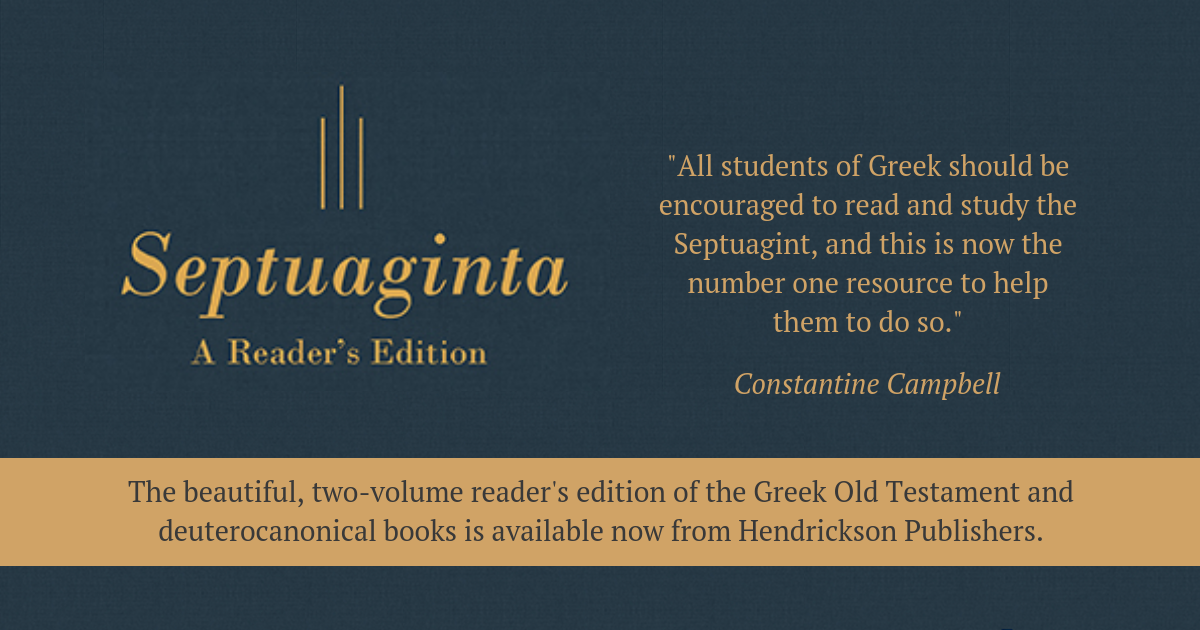So, you like Koine Greek. You cherish the Word of God and want to read it in its original languages. Maybe you’re a Hebrew star, too. Perhaps you’re even dabbling in Aramaic.
In a recent episode of Tool Talk, Greg Lanier and William Ross discussed their new two-volume work, Septuaginta: A Reader’s Edition (Hendrickson). They have spent hours and hours over the past few years reading and studying the Septuagint, that compilation of Greek translations of the Old Testament.
But if you can read the Old Testament in the original languages, then why would you read the Septuagint? After all, didn’t you learn biblical languages to avoid translations?
Maybe you’ve seen the light and you like the Septuagint, perhaps making good use of it in your research, but you don’t include it in any kind of reading plan.
If you aren’t yet settled on reading the Septuagint regularly, this post is for you.
Here are three reasons to read the Septuagint:
1. To See the Old Testament with Fresh Eyes
If you’ve read the Bible in the original languages much at all, you’ve probably noticed the tendency to have some English translation playing in the back of your mind. It’s much easier to think you’re the Hebrew Old Testament well, when in reality, you’re recognizing a few words and filling in the gaps with what you already know about a particular passage. Of course, one of the best ways to overcome this is to read the Hebrew Old Testament more, and you should! But reading the Septuagint allows you to approach the same passages in a language you already know fairly well, but with enough differences to pause your background track of English. Reading the Septuagint regularly will make you slow down and smell the Old Testament roses even more than reading the Hebrew Old Testament. Don’t for a minute let the Septuagint replace your Hebrew reading. Instead, let it supplement and sharpen it.
2. To Understand the Thought World of the New Testament
There’s something of a major cultural shift from the Old Testament to the New and even more so from the New Testament world to yours. Even the Gospels, with their primarily-Jewish context, have major players that are entirely absent in the Old Testament: Pharisees, Synagogues, Centurions, and Sadducees, just to name a few. From where did this milieu come, and how did intertestamental and first-century Jews process the changes? Reading the Septuagint provides a window into the thought world of the New Testament in two ways: First, readers will notice the subtle (and sometimes not-so-subtle) shifts in phrasing from the Hebrew OT to the Septuagint, shedding some light on the understanding of the translators. Second, readers will pick up on deuterocanonical books not included in the Old Testament canon, which provide fascinating insights into the theology and worldview of Second Temple Judaism. Adept readers will compare these books to the New Testament to notice affirmations, denials, and subversions of its views.
3. To Avoid “Over-Exegeting” the New Testament
This was a really interesting point that Will brought up in our interview. The Septuagint gives the reader of the Greek New Testament a much larger well of Koine Greek from which to draw, relatively speaking. Though a word might appear only a handful of times in the Greek NT, its usage in the Septuagint can help broaden the reader’s understanding of its semantic range. What is a unique word to us (when we only look at the NT) might have been far more common to the author. Reading the Septuagint regularly exposes us to more uses of a word in context (something that scanning a lexicon won’t do). This keeps us from drawing out from any given passage what the author never intended—“over-exegesis” that is really just poor exegesis.
One Great Way to Read the Septuagint
So how can you get started? What’s the best way to read the Septuagint regularly?
Obviously, you’ll need to pick up a copy. But you’ll want a solid reader’s edition, like Greg and Will’s. Since most Hebrew and Greek programs only require students to memorize vocabulary that appear a minimum number of times in Scripture (100 instances or more, 50 instances or more, etc.), a reader’s edition of the Hebrew Old Testament or Greek New Testament is a handy tool for those who haven’t memorized every single word that appears in Scripture.
A typical reader’s edition will include basic definitions for words that appear infrequently, so that the average reader can stay in the text instead of flipping through copious pages of a lexicon—a relief for beginners and scholars alike. If you are constantly pausing to collect yourself, you might be translating, but you’re not exactly reading in the way prescribed above.
So, take up and read! Do look into Septuaginta: A Reader’s Edition. Grab a reader’s edition of the Hebrew OT and Greek NT while you’re at it, and be sure to look into great resources that point out quotations and allusions.


